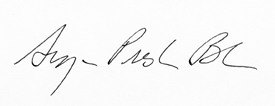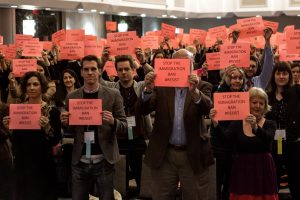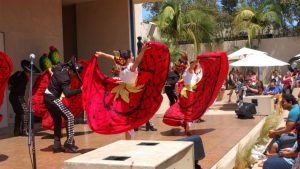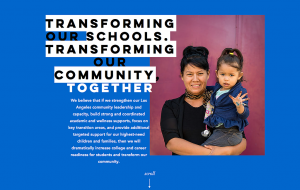CAA News Today
Support the CAA Community on #GivingTuesday
posted by CAA — November 28, 2017
As we celebrate the spirit of generosity on #GivingTuesday, we’re highlighting LA-based organizations to consider giving to alongside CAA.
We thank you for your support!
COLLEGE ART ASSOCIATION
This past year, we fought for the causes of our members and those in the arts and culture field at large. Your contribution helps to ensure that CAA continues our mission in promoting the visual arts and their understanding through advocacy, intellectual engagement, and a commitment to the diversity of practices and practitioners. The larger our voice, the larger the impact we will have.
18TH STREET ARTS CENTER
One of our recommended 2018 conference stops, the 18th Street Arts Center is one of the top twenty artist residency programs in the US. They value art-making as an essential component of a vibrant, just, and healthy society where the creative process is just as important as the outcome.
MUSEUM OF LATIN AMERICAN ART (MOLAA)
Another one of our 2018 conference stops, the Museum of Latin American Art (MOLAA) is the only museum in the United States dedicated to modern and contemporary Latin American art, and serves the greater Los Angeles area.
PROMESA BOYLE HEIGHTS
Promesa Boyle Heights is a collective of residents, youth, schools, and community organizations united in lifting community voices and working together to transform conditions and improve opportunities for students and families in Los Angeles.
Support the Visual Arts Community: Give to CAA’s Annual Fund
posted by CAA — May 24, 2016
 Thank you for being a member of the College Art Association, the world’s leading professional association for the visual arts. As a dedicated member of CAA, you know firsthand about the important work that CAA does to serve and enhance the visual-arts community. We could not do this without your support.
Thank you for being a member of the College Art Association, the world’s leading professional association for the visual arts. As a dedicated member of CAA, you know firsthand about the important work that CAA does to serve and enhance the visual-arts community. We could not do this without your support.
Today, I ask that you join me in celebrating all that CAA does with a gift to the Annual Fund.
Beyond CAA’s ongoing advocacy efforts; vital professional documents like CAA’s Standards and Guidelines; critical projects like the Code of Best Practices in Fair Use for the Visual Arts; prestigious publishing grants for book manuscripts; career-development resources including the Online Career Center; Professional-Development Fellowships in support of promising artists, designers, craftspersons, historians, curators, and critics; important new writing and scholarship published in The Art Bulletin, Art Journal, and caa.reviews; and CAA’s central forum for exchange of creative work and scholarly research at the Annual Conference—CAA does a great deal more to support its members, the lifeblood of the association.
CAA subsidizes over half of its members through discounted membership and registration fees for students, retirees, part-time faculty, and independent artists and scholars. CAA has made part-time faculty issues a priority, recommending that tenured faculty and administrators in the visual arts implement its Guidelines for Part-Time Professional Employment and also providing a resources section on its website for part-time faculty. At the conference, CAA offers Professional-Development Workshops and mentoring opportunities for artists, art historians, designers, and students. CAA is also dedicated to strengthening its support of its international members. Recently CAA launched a section on its website devoted to international topics, the International Desk, which includes reports from around the world and listings of international grants, conferences, and residencies.
In fall 2016, CAA will also launch CAA Connect, the digital social community where CAA members can discuss the latest in visual arts news and practices and collaborate on projects. CAA Connect will boast a number of private and public communities, each with its own discussion threads and resource libraries for multimedia content. We see it as an important tool in bringing together our members and the wider visual arts and humanities fields. Look for CAA Connect to launch in the fall of 2016.
Voluntary support from CAA members is critical to our collective advancement and your contribution to the Annual Fund will enable CAA to continue providing invaluable resources to its members.
On behalf of CAA’s diverse community of artists, art historians, curators, critics, collectors, designers, educators, and other arts professionals, I thank you for your commitment to CAA. Please give generously!
Sincerely,

Doralynn Pines
Vice President for External Affairs
Support CAA with a Gift to the Annual Fund
posted by Nia Page — December 10, 2015
As a member of the College Art Association, you understand the importance of the work of CAA in service to the individuals and institutions that make up the world’s largest international professional community in the visual arts. The Association supports and enhances the field through advocacy efforts on important issues such as those impacting populations, like part-time faculty, and the protection of archaeological and historical sites in countries of conflict, to name a few; vital professional tools like CAA’s Standards and Guidelines; critical projects like the Code of Best Practices in Fair Use for the Visual Arts; prestigious publishing grants for books; career-development resources, including the Online Career Center; Professional-Development Fellowships; new scholarship published in The Art Bulletin, Art Journal, and caa.reviews; and CAA’s forum for exchange of creative work, scholarly research and critical issues in the field at the Annual Conference. None of this would be possible without the support of dedicated members like you.
With an ever-changing academic and museum landscape, CAA is responding to the evolving needs of its constituents. Many new member opportunities are being created, such as flexible and expanded Annual Conference programming, as well as new communication tools and platforms to further our dialogue beyond the conference. Even as CAA innovates, it continues its longstanding leadership in career development for early, mid, and senior level visual-arts professionals.
Today, I ask that you support CAA’s important work with a gift to the Annual Fund. Your contribution will enable us to continue providing invaluable resources and services to members like you. Voluntary support from individuals is critical to our collective advancement, and your contribution to the Annual Fund makes this possible. Your gift will benefit those who share your dedication to the visual arts.
Should you have given in the past, please know that your gift was very much appreciated. We hope you will continue your generosity at the same or even greater level. On behalf of the artists, art historians, collectors, critics, curators, designers, educators, and other professionals who make up CAA, I thank you for your dedication. Please give generously!
Sincerely,
John J. Richardson
VP for External Affairs and President-Elect
P.S. This year’s conference in Washington, DC February 3–6 will be one that you will not want to miss. I look forward to seeing you there.
Support CAA’s Journals with a Gift to the Publications Fund
posted by Nia Page — December 08, 2015
CAA’s publications deliver the world’s leading scholarship in the visual arts in formats that include long-form essays, innovative artists’ projects, and critical reviews. With the addition of our new digital platforms, we can now engage readers with new multimedia forms of scholarly publications and broader interactive functionality.
In The Art Bulletin, online versions of essays can now incorporate supplemental media files, for example, allowing Halle O’Neal to animate the calligraphy on a jeweled pagoda painting and Lisa Pon to model the effects of Raphael’s Acts of the Apostles tapestries on sound and music in the Sistine Chapel. Art Journal’s website, Art Journal Open, publishes probing interviews with artists and curators, most recently by curator Dina Deitsch exploring the creative processes of three artists with whom she worked on exhibitions, William Lamson, Kate Gilmore, and robbinschilds. Our fully open-access online publication caa.reviews now includes about 150 reviews a year, and covers digital publications on diverse topics and geographic regions, like Hypercities: Thick Mapping in the Digital Humanities (book and website, http://www.hypercities.com/). caa.reviews is now read on every continent, and its audience has grown over 100 percent since it became open access in January 2014.
Readers like you enable CAA to carry out our work. Please support our mission of advancing the highest standards of intellectual engagement in the arts by making a fully tax-deductible gift to the Publications Fund today.
Here are some are some highlights from CAA publications:
In The Art Bulletin:
- The long-form essay remains the backbone of the journal. Recent authors have included Sun-ah Choi on the medieval Chinese reception of an Indian statue of the Buddha, Kim Sexton on architectural manifestations of self-government in communal-period Italy, P. Park on surprising sources of artistic inspiration in late Chosŏn Korea,and Therese Dolan and Darcy Grimaldo Grigsby in twin essays on overlooked aspects of Manet’s Olympia
- In the “Whither Art History?” series, prominent art historians trace advances in the discipline, among them Florina Capistrano-Baker on diasporic art andFiliz Yenişehirlioğlu on global elements of Ottoman art and architecture
- Reviews of books on a wide range of topics, from temporality in Mesopotamian art, to the worldwide textile trade from 1500 to 1800, to art history through a Marxist lens
In Art Journal:
- In a project that will be of critical value to both present-day and future art historians and artists, the artist Carolee Schneemann shared thirty pages of key texts, artworks, and photographs from her personal archive; in the artist’s project “Yoga for Adjuncts,” Christian Nagler considered the working conditions of adjunct professors with wily humor
- Recent essays have featured Silvia Bottinelli on nomadism in Italian art and architecture of the 1960s and 1970s, Caroline V. Wallaceon the work of the Black Emergency Cultural Coalition in diversifying US museum exhibitions, Raven Falquez Munsell on the impact of the overthrow of the Chilean Allende government on the 1974 Venice Biennale, and Christopher Tradowsky on Nietzschean ressentiment in current art of a political cast
- Reviews of new books on topics as diverse as how artists sustain their careers, the art of Bruce Nauman, and feminism in museum culture
- The website Art Journal Open launched a new feature, Bookshelf, with annotated snapshots of books in queue on the shelves of scholars and artists such as Steven Nelson, Judith Rodenbeck, and Lenore Chinn
In caa.reviews:
- Recently reviewed books included: Leonardo, Michelangelo, and the Art of the Figure by Michael Cole, Aesthetic of the Cool: Afro-Atlantic Art and Music by Robert Ferris Thompson, Escultura monumental mexica (revised edition) by Eduardo Matos Moctezuma and Leonardo López Luján, and Words Not Spent Today Buy Smaller Images Tomorrow: Essays on the Present and Future of Photography by David Levi Strauss. Exhibitions reviewed include Italian Style: Fashion Since 1945 at the Victoria and Albert Museum, Playthings: The Uncanny Art of Morton Bartlett at the Los Angeles County Museum of Art, Andrew Wyeth: Looking Out, Looking In at the National Gallery of Art, and Radical Presence: Black Performance in Contemporary Art at the Contemporary Art Museum, Houston
These highly regarded journals reach tens of thousands of readers around the world and serve as essential resources to those working in the visual arts—none of which would be possible without your support. Contributors who give at a level of $250 or higher are prominently acknowledged in the publication they support for four consecutive issues, as well as on the publication’s website for one year, through CAA News, and in the Annual Conference’s convocation booklet. On behalf of the scholars, critics, and artists who publish in the journals, we thank you for your continued commitment to maintaining a strong and spirited forum for the visual-arts community.
With best regards,

Gail Feigenbaum
Vice President for Publications
Support CAA’s Publications Fund
posted by Nia Page — June 02, 2015
This year, CAA’s journals made impressive use of their new digital platforms to provide access to their incredibly rich and influential back archive, engage an ever-broadening international audience, and explore new multimedia forms of scholarly publication. These digital efforts augment and support the journals’ longstanding mission to deliver the world’s leading scholarship in the visual arts in forms that engage the field at its most exciting frontiers while maintaining a commitment to the rigorous standards for which they are known.
We invite you to support our mission of advancing the highest standards of intellectual engagement in the arts by making a tax-deductible gift to the Publications Fund today.
Here are some recent highlights from CAA publications:
In The Art Bulletin:
- The long-form essay remains the cornerstone of the journal. Recent authors have included Marvin Trachtenberg on new elements in the history of the basilica of S. Lorenzo in Florence, Mark Rosen on Pietro Tacca’s sculptural portraits of slaves on a seventeenth-century monument in Livorno, Susan Siegfried’s exploration of the intersection of the classical ideal and post-Revolutionary fashion in a painting by Marie-Denise Viller, and Bridget Alsdorf on the figure of the gawker in woodcut illustrations by Félix Vallotton for this novel The Murderous Life
- For the “Whither Art History?” series, prominent art historians from around the world respond to that very inquiry about the direction of the discipline, among them Richard W. Hill Sr. on the art of being indigenous and Moye Okediji on the nature of African art
- Reviews of books on a wide range of topics, from prehistoric visual culture, to eighteenth-century eye miniatures, to humor and politics in recent German art
In Art Journal:
- The journal’s essays have recently featured Anna C. Chave on the career of Carl Andre, Luis M. Castañeda on mid-century art in Haiti, and Kenneth R. Allan on artists influenced by the thinking of Marshall McLuhan
- An artist’s project by Conrad Bakker delved into the library of Robert Smithson, and the artist Brian Molanphy offered a freewheeling annotated bibliography of ceramic art
- Art Journal Open, the journal’s independent website, has lately featured the interview format, with the artists William Lamson, Kate Gilmore, and the art duo robbinschilds each speaking about recent work with the curator Dina Deitsch, and Rudy Lemcke speaking with Tina Takemoto
- Reviews of new books on artists as diverse as Adrian Piper, Andrew Wyeth, and Andy Warhol; on Panamericanism during the Cold War; and on reevaluating modern artists who eschewed abstraction
In caa.reviews (now fully open access!):
- Continual publication reviews on diverse topics and geographic regions, including reviews of books: Performing China: Virtue, Commerce, and Orientalism in Eighteenth-Century England, 1660–1760 by Chi-ming Yang, Grupo Antillano: The Art of Afro-Cuba, edited by Alejandro de la Fuente, and Mio Wakita’s Staging Desires: Japanese Femininity in Kusakabe Kimbei’s Nineteenth-Century Souvenir Photography; and exhibitions: Treasures from Korea: Arts and Culture of the Joseon Dynasty, 1392–1910, Passion and Virtuosity: Hendrick Goltzius and the Art of Engraving, and A Royal Passion: Queen Victoria and Photography
These highly regarded journals reach tens of thousands of readers around the world and serve as essential resources to those working in the visual arts—none of which would be possible without your support. Contributors who give at a level of $250 or higher are prominently acknowledged in the publication they support for four consecutive issues, as well as on the publication’s website for one year, through CAA News, and in the Annual Conference’s convocation booklet. On behalf of the scholars, critics, and artists who publish in the journals, we thank you for your continued commitment to maintaining a strong and spirited forum for the visual-arts community.
With best regards,
Gail Feigenbaum
Vice President for Publications
Support CAA’s Annual Fund
posted by Nia Page — April 27, 2015
Since 1911, the College Art Association has served the individuals and institutions that make up the world’s largest professional association in the visual arts. As you know, CAA supports and enhances the community in the visual arts through advocacy efforts; vital professional documents like CAA’s Standards and Guidelines; critical projects like the Code of Best Practices in Fair Use for the Visual Arts; prestigious publishing grants for book manuscripts; career-development resources including the Online Career Center; important new writing and scholarship published in The Art Bulletin, Art Journal, and caa.reviews; and CAA’s central forum for exchange of creative work and scholarly research at the Annual Conference.
What you may not realize is that CAA does a great deal behind the scenes to support its members. The organization subsidizes more than half of its members through discounted memberships for students, retirees, part-time faculty, and independent artists and scholars, and it provides reduced conference registration fees for student and retired members. CAA’s Strategic Plan (2015–2020) has made part-time faculty issues a priority, and the organization recently asked tenured faculty and administrators in the visual arts to implement its Guidelines for Part-Time Professional Employment. CAA has even devoted an entire website section providing resources for part-time faculty. At the conference, CAA offers Professional-Development Workshops and mentoring opportunities to artists, art historians, designers, and students at the Annual Conference. It also presents ARTspace, an annual forum of programming designed by artists for artists that is free and open to the public.
Today, I ask that you support all that CAA does with a gift to the Annual Fund.
Your contribution to the Annual Fund will enable CAA to continue providing invaluable resources to its members. Voluntary support from CAA members is critical to our collective advancement, and your contribution to the Annual Fund makes this important work possible.
On behalf of the artists, art historians, curators, critics, collectors, designers, educators, and other professionals who make up CAA, I thank you for your dedication. Please give generously!
Sincerely,
John J. Richardson
Vice President for External Affairs
Support CAA’s Journals through the Publications Fund
posted by Nia Page — December 15, 2014
This was an exciting year for CAA’s publications—for the very first time The Art Bulletin and Art Journal were published online using a multi-media platform that allows authors to include video and hyperlinks directly in their essays, and caa.reviews became fully open-access with broader interactive functionality coming soon. Most important, the journals continued to bring readers more of what they expect from the world’s leading publisher of art history journals: exceptional in-depth scholarship exploring the full range of the visual arts, in formats as diverse as long-form essays, innovative artists’ projects, and critical reviews. It is the support of readers like you that enable CAA to carry out this vital work.
Because you share our mission of advancing the highest standards of intellectual engagement in the arts, please make a tax-deductible gift to the Publications Fund today.
Here are some recent highlights from CAA publications:
In The Art Bulletin:
- Continued support of the long-form, peer-reviewed essay, including John K. Papadopoulos reinterpreting the Greek fifth-century BCE Motya Youth, Douglas Brine on the architectural and cultural context of a Jan van Eyck painting, Aaron Wile identifying a distinctly modern sense of self in Wattaeu’s fête galantes, and Joseph Siry on Frank Lloyd Wright’s theater for Dallas
- In the recurring “Whither Art History?” Cheng-Hua Wang examines artistic interaction between China and Europe in the early modern period
- Reviews of books on a wide variety of topics, from Maya art to sixteenth-century sculpture in Florence, from the politics of Mughal architecture to the materiality of color
In Art Journal:
- Projects by artists such as the sculptor Conrad Bakker, the British animator Jonathan Hodgson, and Karen Schiff, whose colorful drawings intervened in the very fabric of the printed journal
- A forum devoted to conceptual art in Latin America in the 1970s, a time of political oppression and upheaval, featuring four essays in the original Spanish and Portuguese with facing-page English translations
- The journal’s open-access website relaunched with a new name, Art Journal Open, and a new editor, the new-media scholar and curator Gloria Hwang Sutton
- Reviews of monographs on the artists Forrest Bess; books by Claire Bishop, Tom Finkelpearl, and Lev Manovich; and a Le Corbusier exhibition at MoMA
In caa.reviews:
- New Field Editor position established for reviews covering Digital Humanities and Art History
- Over 150 book and exhibition reviews across many subject areas and geographic regions
With your support, CAA publications will continue to delight, challenge, and engage readers for many years to come. Contributors who give at a level of $250 or higher are prominently acknowledged in the publication they support for four consecutive issues, as well as on the publication’s website for one year and through CAA News. On behalf of the scholars, critics, and artists who publish in the journals, we thank you for your continued commitment to maintaining a strong and spirited forum for the visual-arts community.
With best regards,

Suzanne Preston Blier
Vice President for Publications
Support CAA with a Gift to the Annual Fund
posted by Nia Page — November 21, 2014
Since 1911, the College Art Association has served the individuals and institutions that make up the world’s largest professional association in the visual arts. Through its journals, standards and guidelines, resources on employment, advocacy, and its forum for exchange of creative and scholarly research at the Annual Conference, CAA supports and enhances the community in the visual arts. Today, I ask that you support all that CAA does with a gift to the Annual Fund.
As an enormously productive year comes to a close, we reflect on some highlights:
- CAA signed a copublishing agreement with Taylor & Francis that brought The Art Bulletin and Art Journal online for the first time
- CAA published Copyright, Permissions and Fair Use among Visual Artists and the Academic and Museum Visual Arts Communities: An Issues Report
- CAA hosted twenty scholars from around the world at the 102nd Annual Conference in Chicago through a Getty-sponsored travel grant program, increasing the organization’s presence globally
- Seven professional-development fellowships were awarded in 2014—two in art history and five in studio art—with awardees each receiving unrestricted grants of $5,000 to help further their careers
- CAA launched an enhanced membership program with new benefits and discounted membership offerings for part-time faculty and independent art historians and artists
Your contribution to the Annual Fund will enable CAA to continue this momentum well into 2015. Voluntary support from CAA members is critical to our collective advancement, and your contribution to the Annual Fund makes this important work possible.
On behalf of the artists, art historians, curators, critics, collectors, educators, and other professionals who make up CAA, I thank you for your dedication. Please give generously!
Sincerely,

Maria Ann Conelli
Vice President for External Affairs
Donate to the Annual Fund
posted by Nia Page — November 27, 2013
For over a century, CAA has proudly represented the individuals and institutions that make up the world’s largest professional association in the visual arts. Since its founding, the organization is known for the engagement and steadfast dedication of its members. CAA is strengthened by every member who serves on a committee or jury, shares research and insight on Annual Conference panels and in journal articles, guides younger colleagues in our mentoring programs, and contributes in so many other ways. I hope we can count on your continued participation and support now and in the years to come.
In return, CAA is devoted to honoring its members’ accomplishments, promoting scholarship, and providing essential resources—serving as the central hub for a vibrant and expanding community of visual-arts professionals. Today, I ask that you join your fellow members with a gift to the Annual Fund to support all that CAA does for the field.
The generous, voluntary support of CAA members is critical to our collective advancement. Only in dialogue can we learn from diverse perspectives. Only with shared purpose can we shape the agenda for policy issues affecting the visual arts. Your contribution to the Annual Fund makes this important work possible.
On behalf of the artists, art historians, curators, critics, collectors, educators, and other professionals who make up CAA, I thank you for your dedicated support; together we are a strong and dynamic visual-arts community. Please give generously!
Sincerely,

Maria Ann Conelli
Vice President for External Affairs
Support CAA’s Journals with a Gift to the Publications Fund
posted by Nia Page — November 26, 2013
This year CAA’s three journals—The Art Bulletin, Art Journal, and caa.reviews—brought readers more of what they have come to expect from the world’s leading publisher of art-history journals: exceptional scholarship exploring the full range of the visual arts in formats as diverse as long-form essays, groundbreaking digital-media projects, and critical reviews. In today’s media landscape of repackaged content and 140-character tweets, sustaining the publication of in-depth, thought-provoking content is a challenge—it is the support of readers like you that enables CAA to do so. Because you share our mission of advancing the highest standards of intellectual engagement in the arts, please make a tax-deductible gift to the Publications Fund today.
Here are some highlights from CAA publications over the past year:
In The Art Bulletin:
- In celebration of The Art Bulletin’s centenary, eight past editors wrote reviews essays reflecting on the critical impact and afterlife of significant books published since the journal’s founding in 1913
- In the innovative “Notes from the Field,” ten authors took on a new theme in each issue: materiality, mimesis, time, and tradition. The interdisciplinary features, with texts by artists, archaeologists, literary critics, and curators as well as art historians, have proven popular in the classroom, especially at the undergraduate level
- The Art Bulletin continues to champion the long-form essay, this year including texts by Peter Parshall on Dürer, Namiko Kunimoto on Tanaka Atsuko, and David M. Stone on Caravaggio
In Art Journal:
- A rare publication of the 1957 Elbe, a series of thirty-one prints by Gerhard Richter, illustrated an essay by Christine Mehring in the Winter 2012 issue
- Moyra Davey contributed photographs and text for a ten-page artist project titled “Burn the Diaries” to the Spring 2013 issue
- In the Summer 2013 forum “Conversations on Queer Affect and Queer Archives,” seventeen artists and writers reflected on the vital importance of LGBT archives around the world for both artists and art historians
In caa.reviews:
- This fall, caa.reviews celebrates fifteen years of publishing critical reviews of books, exhibitions, and projects in all areas and periods of art history and visual studies
- Using the Scalar digital platform, caa.reviews provided an immersive, multimedia experience of the recent exhibition Bernini: Sculpting in Clay, with an array of critical texts and images as well as a virtual walk-through of the show
- The essay “Reflections on Photography” by Tanya Sheehan kicked off a new thematic series titled “Re-Views: Field Editors’ Reflections,” in which the journal editors assess—or re-view—their respective fields as seen through the lens of the reviews they have commissioned
With your support, CAA publications will continue to delight, challenge, and engage readers for many years to come. On behalf of the scholars, critics, and artists who publish in the journals, we thank you for your continued commitment to maintaining a strong and spirited forum for the visual-arts community.
With best regards,

Suzanne Preston Blier
Vice President for Publications






